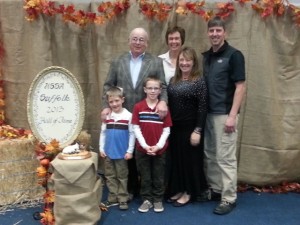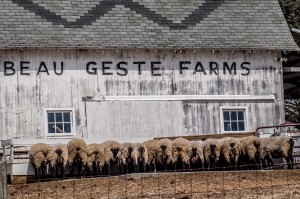Oskaloosa Family Inducted Into USSA Hall Of Fame

Joe Warrick (back left) with his family at his induction into the USSA Hall of Fame. (submitted photo)
Oskaloosa, Iowa – Each town has its own story and history, and Oskaloosa is no different. From famous admirals to its own minor league baseball team, Oskaloosa and it’s residents have made their mark on history.
A couple more of those people in Oskaloosa who have helped make their mark in history are the Warrick’s, Roy and his son Joe. These two were recently honored by their peers.
Joe Warrick and his late father Roy were recently inducted into the United Suffolk Sheep Association Hall of Fame in Louisville, Kentucky.
The USSA helps Suffolk sheep breeders document the lineage of their sheep in much the same way dogs have papers to identify lineage.
Roy Warrick, father of Joe, was originally in the Hampshire sheep business. One day in 1947, a seller of Hampshire sheep visited the Southern Iowa Fairgrounds with a dozen Hampshire rams from England. He had brought them to auctioned them off. Roy and two others bought the high selling ram of the day for $800. Eventually, Roy bought out the other two to become the sole owner of Shapwood Beau Geste. “He really produced some really outstanding lambs for him,” Joe said of the ram, who’s name became the namesake of their farm. Their farm is still, to this day, called Beau Geste Farms.
Roy was looking for another breed. “He thought about the Columbia breed, but after talking to Phillip Rock of Drumheller, Alberta, Canada, he decided that Suffolk was the breed of the future because of their size, fast growth and lambing ease. Roy was a strong supporter of the Suffolk sheep business which was a little known breed at the time.”
The Warrick’s first flock was Canadian Pacific Railway ewes. “That became the nucleus of our flock, and then he (Roy) got a ram from Phil called 118D. That ram then produced the Warrick’s own stud, ram 44F, and that ram was our main stud ram for 10 years,” said Joe.
With the induction into the USSA Hall of Fame inaugural class, it speaks of the families prominence in the industry. “I know my father did a tremendous amount of promoting the business (Suffolk sheep)” Joe said of his father Roy.
The Warrick’s part in the sheep business has been to provide rams that will improve the commercial stock of sheep. “One of the reasons the Suffolk became popular… in the 50’s is because they were easy lambing, they ranged well and were not hard keepers,” said Joe. “They would stay fat on grass during the summertime.”
“Dad did lots and lots of work in promoting the sheep business; promoting the Suffolk’s,” said Joe. “He use to travel all over the country doing it.”
Roy passed away in 1969 at the age of 62.
Joe had traveled with his father to many shows and different sales across the United States, as well as Canada.
The family also hosted an annual sale at the Southern Iowa Fairgrounds on Memorial Day. “We had probably the longest individual production sale in the United States,” Joe said. He explained that there are longer running consignment sales, but no one ran a longer running individual producer sale than his family. The annual sale ended in the early 1990’s.
Joe then continued to show at several major fairs and other events, and today he remains an active sheep judge.
Today, Joe maintains a flock of sheep to help educate his grandchildren about the business, while helping his daughter, Jennifer Peterson, and his son-in-law, Dr. Nathan Peterson, with their Boer goats.
Suffolks are raised for their meat, not for their wool, which is what we traditionally think of when thinking about sheep. The Suffolk does produce a medium grade wool that would be used in carpet and similar types of products. A white-faced breed of sheep would provide the fine wool, Suffolk are a black-faced breed.
Today, the industry is different than it once was. “We don’t have the commercial buyers we used to have,” said Joe of the current economics in the breed. “We don’t have the big commercial flocks out there anymore.”
Some of this downturn can be traced back to trade practices between the United States and its trading partners, and tariffs that were once in place, such as the Wool Act.











